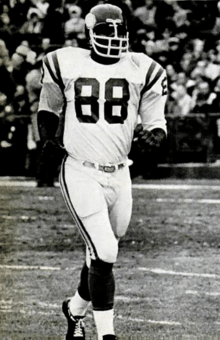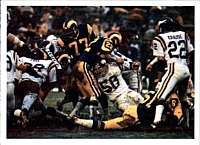Purple People Eaters

Purple People Eaters were the defensive line of the Minnesota Vikings from the late 1960s to the late 1970s. The term is a reference to a popular song from 1958, the efficiency of the defense, and the color of their uniforms. The motto of the Purple People Eaters was "Meet at the quarterback."[1]
- Defensive tackle Alan Page, 9 Pro Bowl Selections (1968–1976), NFL MVP (1971), Hall of Fame[2]
- Defensive end Carl Eller, 6 Pro Bowl Selections (1968–1971, 1973–1974) Hall of Fame[3]
- Defensive end Jim Marshall, 4 Pro Bowl Selections (1968–1971)[4]
- Defensive tackle Gary Larsen, 2 Pro Bowl Selections (1969–1970)[5]
One of the original members of the defensive line, Gary Larsen, was replaced in the mid-1970s by Doug Sutherland.[6]
Marshall said that the players disliked "Purple People Eaters" and called themselves "The Purple Gang", but "we've got to ride with it because it's our handle".[7] The group was a major factor in the post-season success of the Vikings from the late 1960s through the 1970s.[8] The Purple People Eaters were one of the most identifiable front fours in National Football League history, with the "Fearsome Foursome" of the Los Angeles Rams during the 1960s and early 1970s, the "Steel Curtain" of the Pittsburgh Steelers during the 1970s, and the "New York Sack Exchange" of the New York Jets during the 1980s.
Carl Eller and Alan Page were inducted into the Pro Football Hall of Fame. Many fans, players, coaches and sportswriters argue that Jim Marshall should be in the Hall of Fame as well.[9]
Building the Purple People Eaters


.png)
Purple People Eaters also appeared in: Judy Moody, Mood Martian

When the Minnesota Vikings first came into the NFL in 1961, they picked up Jim Marshall from the Cleveland Browns during a number of early September trades that moved six Cleveland players to the Vikings for two 1962 draft picks. In 1964, Carl Eller was drafted in the first round. In the next season, they acquired Gary Larsen from the Los Angeles Rams. Then in 1967, the Vikings drafted Alan Page in the first round.
Late '60s and Early '70s

In 1968, Marshall, Eller and Page all made the Pro Bowl as the Defense collected 44 sacks, ranked 6th in the league in points allowed and played a big role in the Vikings winning their first division title.
In 1969, Marshall, Eller, Page and Larsen all made the Pro Bowl as the defense sacked the opposing quarterback 49 times and ranked number 1 in both points allowed and yards allowed. Meanwhile, their offense scored the most points. On Thanksgiving against Detroit Lions, Jim Marshall and Alan Page combined for one of the most remarkable plays in NFL history. Page tipped a pass which fell into the hands of Marshall, who then started running towards the endzone. Then, as Marshall was being tackled, he lateraled the ball to Page who then had an easy path to the end zone. The Vikings won the game 27-0. In the Western Conference championship game, the Vikings hosted the Los Angeles Rams. Early in the game, Carl Eller intercepted Rams quarterback Roman Gabriel and ran 46 yards into the end zone, but the touchdown was called back on a controversial offside penalty on Alan Page. Late in the fourth quarter, the Vikings defense needed to protect a one-point lead. Eller extended the lead by sacking Gabriel in the end zone for a safety. The Rams got the ball back with still some time left to win, but Page made up for his earlier penalty by intercepting Gabriel and put the game out of reach as the Vikings won 23-20. The win allowed the Vikings to advance to their first ever NFL Championship against the Cleveland Browns. The Vikings dominated the game defeating the Browns 27-7. The Vikings advanced to Super Bowl IV but lost to the Kansas City Chiefs in a 23-7 upset.
The Vikings opened up the 1970 season in a Super Bowl IV rematch against the Chiefs. Early in the second quarter, Jim Marshall recovered a fumble and then lateraled the ball to Roy Winston as he was being tackled. Winston went on to score a touchdown and give the Vikings a 10-0 lead. That play set the tone as the Vikings defense dominated the game, limiting the chiefs to 63 yards rushing and forcing 4 turnovers en route to a 27-10 victory. In a week 4 game against the Chicago Bears, all 4 down linemen hit Bears quarterback Jack Concannon, forcing a fumble which was recovered by Alan Page who then returned it 65 yards for a touchdown. The Vikings won the game 24-0. That year Page led the league with 7 fumble recoveries for 77 yards and a touchdown. The Vikings defense recorded 49 sacks and once again gave up the fewest points and the fewest yards. Meanwhile, Page, Eller and Larsen all made the Pro Bowl.
In 1971, The Vikings defense ranked 2nd in fewest yards allowed and for the third year in a row, first in fewest points allowed. That year, Carl Eller was voted NEA NFL Defensive Player of the Year and to his 4th straight pro bowl. Meanwhile, Defensive tackle Alan Page became the first defensive player to be voted NFL MVP, and the only defensive lineman to ever earn the honor. Alan Page's MVP season is highlighted by his Week 13 performance against the Detroit Lions. In the second quarter, after being called for a personal foul and for roughing the passer on consecutive plays, Page sacked QB Greg Landry on first down. On second down, Page tackled Altie Taylor for a 4-yard loss. On third down, Page tackled Landry after a gain of two yards, ending the drive. In the fourth quarter, Page blocked a Lion punt out of the end zone for a safety.
3 Super Bowls in 4 years
With the Vikings intimidating line leading their defense and their future Hall of Fame quarterback Fran Tarkenton leading the offense, the Vikings went on to participate in Super Bowls VIII, IX, and XI. In 1973, Alan Page was named NEA Defensive player of the year as the Vikings would return to their second Super Bowl in five years.
In 1974, Doug Sutherland would start in place of Gary Larsen and continue for the next seven years. Sutherland would go on to start in Super Bowl IX as the Vikings were once again NFC Champions. Super Bowl IX would be Larsen's last game.
In 1975 the Vikings' defense recorded 46 sacks and ranked number one in fewest rushing yards allowed and passing yards allowed. Meanwhile, Tarkenton was named NFL MVP. The season would come to a disappointing end as the Cowboys would pull off a Hail Mary pass to beat the Vikings in the Divisional round 17-14. The win was not without controversy as fans continue to argue that Cowboys receiver Drew Pearson pushed Vikings cornerback Nate Wright in order to make the catch.[10]
In 1976, The Vikings won another divisional title and made it to their third Super Bowl in four years and fourth overall. But for the fourth time, they lost. That year, Alan Page accounted for 18 of the Vikings 45 sacks.
In 1977, The Vikings won yet another division title and made it to their 4th NFC Championship in 5 years. That Year Carl Eller accounted for 15 of the Vikings 30 sacks.
Retirement
After six games during the 1978 season, Alan Page was waived by the Vikings and then signed by the Chicago Bears, where he collected 40 sacks before he retired in 1981. Page played in 218 consecutive games without an absence (215 consecutive in the starting line-up).
After the 1978 season, Carl Eller was traded to the Seattle Seahawks, where he collected three more sacks in his final season. In his 16-year career, Eller only missed three games and started 209 out of 225 he played.
After the 1979 season, Jim Marshall retired. In 20 seasons (19 with the Vikings and 1 with the Cleveland Browns) Marshall never missed a game and set what was then a National Football League record with 282 consecutive games, including 270 consecutive starts with the Vikings. After his last home game, Marshall was carried off the field by his teammates in celebration.[11]
Page was inducted into the Pro Football Hall of Fame in 1988 and Eller was inducted in 2004. Marshall is currently ranked number 2 on the list of top ten players that are not in the Hall of Fame.[9]
References
- ↑ "Football: The Four Norsemen". TIME Magazine. 1969-10-17. Retrieved 2011-05-28.
- ↑ "Pro-Football-Reference: Alan Page". Retrieved 2008-02-08.
- ↑ "Pro-Football-Reference: Carl Eller". Retrieved 2008-02-08.
- ↑ "Pro-Football-Reference: Jim Marshall". Retrieved 2008-02-08.
- ↑ "Pro-Football-Reference: Gary Larsen". Retrieved 2008-02-08.
- ↑ "The List: Best sports unit nickname of all time". Retrieved 2008-02-08.
- ↑ Corbett, Jim (2015-01-24). "Seahawks' 'Legion of Boom' latest of legendary nicknames". USA Today. Retrieved 2017-10-25.
- ↑ "Pro-Football-Reference: Minnesota Vikings". Retrieved 2008-02-08.
- 1 2 "Top Ten Not in HOF: Jim Marshall". nfl.com. Retrieved 2011-05-28.
- ↑ "1975 Rewind: Drew Pearson Insists He Didn't Push Off". New York Times. 2010-01-16. Retrieved 2011-05-28.
- ↑ Cotton, Anthony (1979-12-24). "A Man For 20 Seasons: Old Indestructible, Jim Marshall of the Vikings, retires after 302 straight games". Sports Illustrated. Retrieved 2011-05-28.